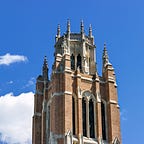Polar attraction
In search of subatomic particles, Dr. Karen Andeen has camped at the South Pole and maintains contact there
By Lauren Sieben
Dr. Karen Andeen’s work as a physicist has taken her where few other scientists, let alone ordinary citizens, have gone before: the frigid tundra of the South Pole.
With oppressively cold temperatures, averaging minus 80 Fahrenheit in winter, this pocket of Antarctica contains no native flora or fauna. There are no cities or towns, and no permanent residents. But scientists like Andeen head there to work at the IceCube Neutrino Observatory, which houses a telescope designed to observe neutrinos — nearly-massless subatomic particles that contain no electrical charge. The South Pole’s dark, clear ice creates ideal conditions for identifying neutrinos during rare occasions when they interact with matter and create a glowing blue light.
Andeen, an assistant professor of physics, began working with IceCube as a graduate student at the University of Wisconsin–Madison in the mid-2000s. The project was just getting underway, pursuing knowledge about a little-understood particle. “If you’ve heard of neutrinos, you’re lucky, because most people don’t talk about them at all in intro physics classes,” Andeen says. It was only in 2001 that research confirmed that neutrinos have mass.
In Madison, Andeen ran tests on IceCube’s digital optical modules, which were kept in massive freezers meant to replicate extreme polar temperatures. In 2008 Andeen embarked on her first trip to the observatory to deploy the modules she had tested in the lab. She returned for a second trip to IceCube in 2009, and today, from Marquette, she maintains contact with the Antarctic facility, pulling readings from its sensors for her research.
The experience at the observatory was as exhilarating as it was unusual: Andeen spent long days in the brutal cold deploying optical modules that weighed up to 30 pounds each. She worked alongside oil drillers hired to drill deep into the ice so that the modules could be deployed more than a mile below the surface.
It was grueling physical work, and it was also easy to lose track of time, as the sun constantly illuminated the base during the South Pole’s summer months. The crew’s work was divided between day, swing, and night shifts. “I think I was mostly on days, but I wouldn’t have known,” Andeen says.
Andeen moved on from the IceCube project after earning her doctorate, then completed postdoctoral work in New Jersey and in Switzerland. But she knew she wanted to return to the Midwest to teach and conduct research. When an opportunity arose, she eagerly joined Marquette’s physics faculty — and rejoined IceCube, where she’s again a team member, working remotely for now.
Andeen’s research aims to fill in existing gaps in cosmic ray physics — key information regarding their creation, acceleration and propagation that is lacking, even though these rays constantly bombard earth’s atmosphere. With a new National Science Foundation grant, she will expand her analysis of cosmic rays and develop upgrades to IceCube’s surface detectors, which will generate data supporting new neutrino and cosmic ray insights.
Andeen’s renewed partnership with IceCube has brought with it valuable opportunities for Marquette undergraduates too. In the basement of the Wehr Physics Building, students are building a prototype of a new surface detector for IceCube, complete with an industrial-size freezer used for running tests at arctic temperatures.
“In particle physics, it’s hard for students to get hands-on experience,” says the professor who’s worked alongside oil drillers. “Particularly women get tracked toward data analysis. I like doing hardware projects in my lab so I can say to women students, ‘Yes, you definitely can get hardware experience here on campus.’”
Adapted from the spring-summer 2019 issue of Marquette Magazine. View more web stories from the issue or the entire print edition online.
